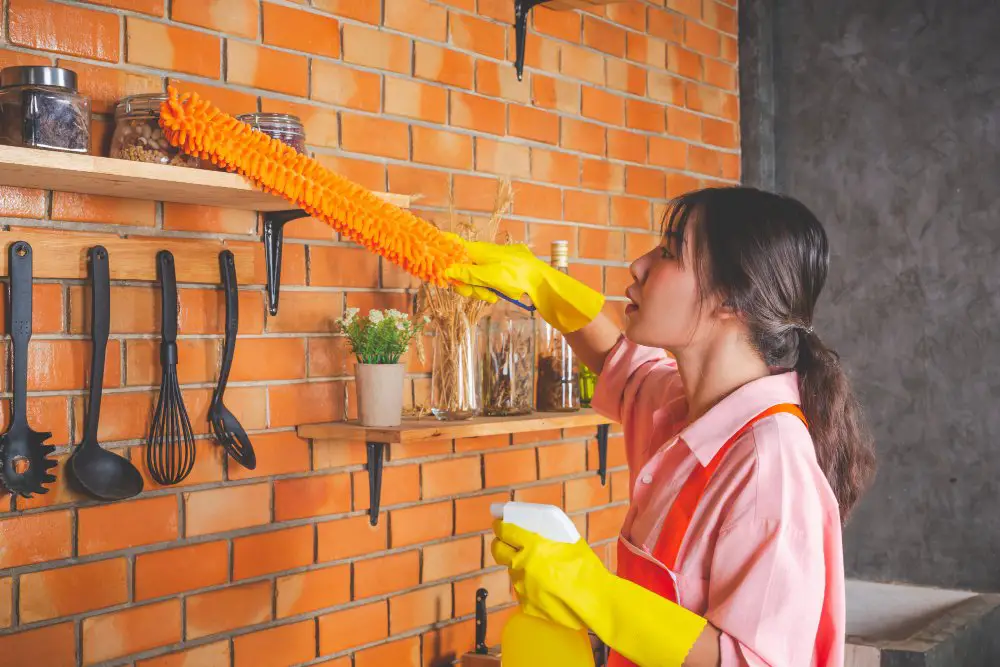Last updated on
Discover effective strategies to declutter your home and maintain harmony when living with a hoarding spouse, by following our practical tips and guidance.
Welcome to my blog, where we explore the art of decluttering and organizing. Today’s topic is a tough one, but an important one for many of us: how to declutter when your husband is a hoarder.
Living with someone who has hoarding tendencies can be overwhelming and stressful, but it doesn’t have to be that way forever. In this article, I will share some expert tips on how to approach this delicate situation with compassion and understanding while still achieving your goals of creating a clutter-free home.
So grab a cup of tea, take a deep breath, and let’s dive in!
Key takeaways:
- Identify hoarding signs with sensitivity and empathy.
- Communicate concerns without judgment and encourage open dialogue.
- Set realistic goals and prioritize areas to declutter.
- Consider involving a professional organizer for guidance and support.
- Seek therapy support to manage stress and develop coping mechanisms.
Table of Contents
Identifying Hoarding Signs

The first step in decluttering when your spouse is a hoarder is to identify the signs of hoarding. Hoarding disorder is a mental health condition that affects millions of people worldwide, and it can manifest in different ways.
Some common signs include difficulty discarding items, excessive clutter, avoidance of visitors or social events due to shame about the home’s state, and emotional attachment to objects.
It’s essential to approach this topic with sensitivity and empathy towards your partner while acknowledging that their behavior may be causing distress for both parties. If you suspect that your spouse has hoarding tendencies, try having an open conversation with them about how they feel regarding their possessions’ accumulation.
Remember not to judge or criticize them but instead listen actively without interrupting or dismissing their feelings. This will help create an environment where they feel comfortable sharing more information about why they hold onto certain things.
Communicating Concerns

It’s important to approach the conversation with empathy and understanding, as hoarding behavior often stems from underlying emotional issues. Start by expressing how their behavior makes you feel and how it affects your daily life.
Avoid using accusatory language or making them feel ashamed of their actions.
Instead, focus on finding common ground and working together towards a solution that benefits both parties. Encourage open communication by actively listening to their perspective without judgment or interruption.
Remember that change takes time, so be patient and supportive throughout the process. Celebrate small victories along the way to keep motivation high for both yourself and your partner.
Setting Realistic Goals

It’s important to remember that change won’t happen overnight and that small steps can lead to significant progress over time. Start by identifying the areas of your home that need the most attention and prioritize them accordingly.
For example, if your husband has a collection of items he’s emotionally attached to, such as old magazines or newspapers, you may want to start by discussing which ones are truly meaningful and which ones can be let go of. This process may take some time but approaching it with patience and understanding will help make it more successful.
It’s also essential not only for you but also for your partner in this journey towards decluttering success; setting unrealistic expectations could cause frustration or even resentment towards each other when things don’t go according to plan.
Prioritizing Areas to Declutter

However, tackling everything at once can be overwhelming and may not yield the best results. Prioritizing areas of your home that need immediate attention is a great way to make progress while avoiding burnout.
Start by identifying high-traffic areas such as living rooms or kitchens where clutter can quickly accumulate. These spaces are often used for entertaining guests or daily activities, so keeping them tidy will help reduce stress levels in both you and your spouse.
Next, consider prioritizing storage spaces such as closets or garages where items tend to pile up over time. These areas may require more effort but clearing them out will create more space for other belongings that need organizing.
Remember that decluttering is a process; it won’t happen overnight but taking small steps towards achieving an organized home will lead to long-term success.
Involving a Professional Organizer

A professional organizer can provide objctive guidance and support, helping you to create a plan of action that works for both you and your spouse. They will work with you to identify the root causes of the clutter, develop strategies for decluttering, and establish systems to maintain order in your home.
When choosing a professional organizer, look for someone who has experience working with hoarders or individuals who struggle with chronic disorganization. You want someone who is compassionate but firm enough to help keep things on track.
Working alongside an expert can also help alleviate some of the tension between spouses when it comes time to make difficult decisions about what items should stay or go. With their expertise in organizing spaces efficiently while keeping sentimental items safe from harm’s way; they’ll ensure that every item has its place without causing any further stress on either party involved.
Seeking Therapy Support

It’s essential to take care of your mental health while decluttering your home. Seeking therapy support is an excellent way to manage the stress that comes with this process.
A therapist can help you develop coping mechanisms, set boundaries, and communicate effectively with your partner about their hoarding tendencies.
Therapy sessions also provide a safe space for you to express yourself without judgment or fear of hurting anyone’s feelings. You may find it helpful to attend individual therapy sessions or couples counseling if both partners are willing.
Remember that seeking therapy support does not mean there is something wrong with you; it merely means that you recognize the importance of taking care of yourself during this challenging time in your life.
Establishing Maintenance Routines

This is especially crucial when living with a hoarding spouse as they may be more prone to accumulating items over time. One effective way of maintaining an organized space is by setting aside a few minutes each day for quick cleanups and organizing tasks.
For example, make it a habit to put things back in their designated places after use or do small cleaning tasks like wiping down surfaces or sweeping the floor daily.
Another helpful tip is scheduling regular decluttering sessions every few months where you can reassess what items are still needed and what can be donated or discarded. It’s also essential that both partners agree on these routines and work together towards maintaining them consistently.
Remember that establishing maintenance routines takes time, effort, and patience but the benefits of having an organized home are worth it in the long run!.
Utilizing the ‘Maybe Box’ Approach
One effective strategy for decluttering when your husband is a hoarder is to utilize the “Maybe Box” approach. This method involves setting aside a designated box or area where items that you are unsure about can be temporarily stored.
Instead of immediately deciding whether to keep, donate, or discard these items, place them in the Maybe Box and revisit them after a set period of time, such as one month. During this waiting period, encourage your husband to reflect on whether he truly needs or values these items.
By creating some distance and allowing for reflection before making final decisions, the Maybe Box approach helps reduce emotional attachment and makes it easier to let go of unnecessary belongings over time.
Designating Clutter-Free Zones in the House
These areas serve as peaceful havens where you can relax and enjoy a tidy environment, even if the rest of the house may still be cluttered. Start by identifying one or two rooms or specific areas that will be designated as clutter-free zones.
This could include spaces like the bedroom, living room, or home office.
Once you have chosen these zones, make it clear to your husband that they are off-limits for any unnecessary items and should remain clean and organized at all times. Set boundaries together and establish rules about what can be brought into these spaces.
To maintain these clutter-free zones effectively, create storage solutions within them so that everything has its place. Invest in shelves, baskets, bins or other organizational tools to keep belongings neatly stored away when not in use.
Establishing a System for Organizing Items
This involves creating designated spaces and implementing consistent storage solutions throughout the house. Start by decluttering one area at a time, sorting items into categories such as keep, donate, or discard.
Once you have identified what should be kept, assign specific places for each item based on its purpose or frequency of use.
Invest in storage containers like bins, baskets, and shelves to help keep things organized and easily accessible. Label these containers clearly so that both you and your husband can quickly locate items when needed.
Consider using color-coded systems or visual cues to make it even easier to find things at a glance.
Remember that consistency is key in maintaining an organized home with someone who struggles with hoarding tendencies. Encourage your husband’s involvement in the process of establishing this system so he feels included and invested in keeping the space clutter-free together.
Developing Positive Reinforcement Strategies
Instead of criticizing or nagging, try offering praise and rewards for progress made. Celebrate small victories together and acknowledge the effort put into decluttering.
This can help create a more supportive environment and motivate your husband to continue letting go of unnecessary items. Consider setting achievable goals and rewarding yourselves with something enjoyable once those goals are met, such as going out for a nice dinner or planning a fun outing together.
By emphasizing positivity throughout the process, you can encourage your husband’s willingness to let go of clutter while strengthening your relationship in the process.
Tactics for Slowing Down Influx of New Items
Here are some tactics that can help slow down the influx of new belongings:
1. Open Communication: Start by having an open and honest conversation with your husband about his shopping habits and why it’s important to reduce clutter in your home.
Discuss how acquiring fewer items can lead to a more organized and peaceful living environment.
2. Set Clear Boundaries: Establish boundaries regarding what types of items are allowed into the house and how many should be brought in each month or week.
This could include agreeing on limits for clothing, gadgets, or collectibles.
3. Implement Waiting Periods: Encourage your husband to adopt a waiting period before making any non-essential purchases.
Suggest waiting at least 24 hours before buying something impulsively, as this allows time for reflection on whether it is truly necessary or just another item that will contribute to clutter.
- Impose Space Constraints: Allocate specific areas within the home where new items can be stored so they don’t take over every available space in sight immediately upon arrival.
- Encourage Experiences Over Things : Shift focus from material possessions towards experiences by suggesting activities such as going out for dinner together instead of buying kitchen gadgets or planning weekend getaways instead of accumulating more stuff.
- By implementing these tactics, you’ll not only slow down the inflow of new belongings but also encourage mindful consumption habits that support decluttering efforts while maintaining harmony within your household
FAQ
How do I stop my husband from hoarding?
Encouraging your husband to seek cognitive behavioral therapy can help tackle his hoarding behavior as it aids in understanding root causes for clutter accumulation and difficulties in discarding items.
What should you not say to a hoarder?
Avoid using offensive terms like "junk", "garbage", or "trash" when referring to a hoarder’s items as it can upset them and result in further social withdrawal.
What are the most effective strategies for minimizing belongings in a cluttered home?
The most effective strategies for minimizing belongings in a cluttered home include the KonMari method of disposing items that do not spark joy, the four-box method of sorting items into categories, the 12-12-12 challenge to find a dozen items to toss, donate, and return, the project 333 system for streamlining wardrobes, and the 80/20 rule to eliminate rarely used items.
How can one motivate a family member to participate in a decluttering process?
Motivating a family member to participate in a decluttering process can be achieved by involving them in the decision-making, showing them the benefits of a clutter-free space, making the process fun and rewarding, and giving them a role or responsibility that suits their abilities or interests.
How can a professional organizer aid in addressing household hoarding issues?
A professional organizer can assist with household hoarding issues by developing a systematic decluttering plan, teaching organizing skills, and providing support and motivation to overcome emotional barriers tied to belongings.




